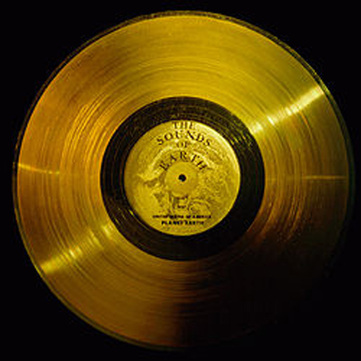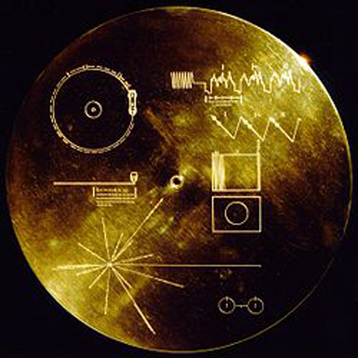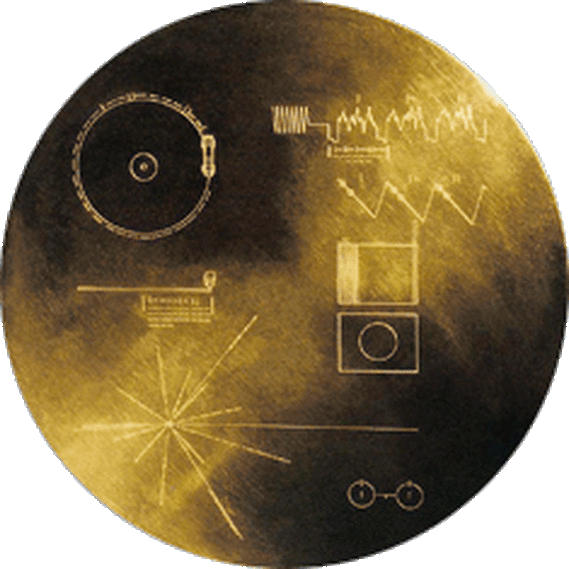nobody, not even the rain, has such small hands
The Voyager program is an American space program that launched two unmanned space probes,Voyager 1 and Voyager 2, on September 5, 1977. The launch was timed to take advantage of what was considered to be a favorable alignment of planets that occurred in the late 1970s. Officailly, the Voyager probes were only designated to explore the outer Solar System (Jupiter, Saturn, Uranus and Neptune) but were peripherally designed to continue their mission indefinitely.
The Voyager Golden Records
The Golden Records contained on Voyager 1 & 2 are phonographic records (gold-plated audio-visual discs):
The discs contain certain sounds and images selected to represent the diversity of both life and culture on Earth (listed below). Ultimately, the hope is that any intelligent extra-terrestrial life forms, or perhaps even future humans, might find this "time capsule" and know of us. While the Voyager spacecraft are not on any precise heading, it is projected that Voyager 1 will pass within 1.6 light years of the star Gliese 445, currently a part of the Camelpardalis constellation, in 40,000 years!
Voyager 2 is expected to enter interstellar space within a few years of 2016, and its plasma spectrometer should provide the first direct measurements of the density and temperature of interstellar plasma.
The chances of either probe being detected and intercepted in deep space are quite small as not only is the probability of a space-faring civilization encountering them very limited, but both, should either Voyager probe actually remain in tact, will eventually stop emitting the electromagnetic radiation needed for a long-distance location and communication.
Ultimately, Carl Sagan, the American astronomer, astrophysicist and cosmologist who chaired the committee for the selection if the contents of the discs, noted that the Voyager project was less about a serious attempt to communicate with extra-terrestrial life, and more about the (then current) state of civilization on planet Earth.
Contents of the Golden Discs
Carl Sagan, Committee Chair and his associates assembled 116 images and a variety of naturally occurring Earth sounds. Also included were musical selections from different cultures, eras, spoken greetings in 55 ancient and modern languages, and printed messages from US President Jimmy Carter and the UN Secretary-General Kurt Waldheim.
The images, photographs and diagrams in both black and white and color are of various topics deemed to be most indicative of life on Earth. The first images are scientific in nature showing mathematical and physical quantities, our Solar System, DNA, human anatomy and reproduction systems, anatomy of animals, diagrams of insects, plants, and various biomes. Human cultural references focus on the diversity of cultures and their architecture, food, dress, and portraits of "every-day" life routines. Many of the pictures are annotated with one or more indications of scales of time, size or mass or chemical composition. All measures used on the pictures are defined in the first few images using physical references that are likely to be consistent anywhere in the universe.
The 116 images are encoded in analogue form and composed of 512 vertical lines. The remainder of the record is audio, designed to be played at 16 and two-thirds revolutions per minute.
The images, photographs and diagrams in both black and white and color are of various topics deemed to be most indicative of life on Earth. The first images are scientific in nature showing mathematical and physical quantities, our Solar System, DNA, human anatomy and reproduction systems, anatomy of animals, diagrams of insects, plants, and various biomes. Human cultural references focus on the diversity of cultures and their architecture, food, dress, and portraits of "every-day" life routines. Many of the pictures are annotated with one or more indications of scales of time, size or mass or chemical composition. All measures used on the pictures are defined in the first few images using physical references that are likely to be consistent anywhere in the universe.
The 116 images are encoded in analogue form and composed of 512 vertical lines. The remainder of the record is audio, designed to be played at 16 and two-thirds revolutions per minute.
General Information about Voyager 1 & 2
As of April 17, 2014, both Voyager 1 & 2 have been operational for 36 years, 7 months and 12 days and are roughly the staggering distance of 127.22 AU (1.903x1010km) from Earth, making them the farthest known human-made objects from Earth.
Voyager 1 & 2 both use the Deep Space Network to both receive commands and relay data back to Earth.
Both spacecraft are expected to continue their missions until about 2025 when they will no longer be supplied with enough power from its generators to operate any of their instruments.
Information Specific to Voyager 1
On September 12, 2013, NASA received information from the Deep Space Network announcing that Voyager 1 had crossed the heliopause* and entered interstellar space**
* The heliopause is the theoretical boundary of where the solar winds of the Sun are arrested by the interstellar medium;*** and the solar wind's strength is no longer great enough to push back the stellar winds of the surrounding stars. It is known to lie far outside the orbit of Neptune.
**Interstellar space is the physical space within a galaxy not occupied by stars or their planetary systems.
**The Interstellar medium (ISM) is the matter that exists in the space between the star systems in a galaxy.
**Interstellar space is the physical space within a galaxy not occupied by stars or their planetary systems.
**The Interstellar medium (ISM) is the matter that exists in the space between the star systems in a galaxy.
Information Specific to Voyager 2
The primary mission of Voyager 2 ended December 31, 1989 after an impressive list of achievements including encountering the Jovian System (1979) the Saturnian System (1981) the Uranian System (1986) and the Neptunian System (1989). Voyager 2 is the only spacecraft to have visited the two outer giants, Uranus and Neptune.
Voyager 2 is currently moving at a rate of 15.428 km/s relative to the Sun.
Voyager 2 is currently moving at a rate of 15.428 km/s relative to the Sun.
The Greetings from the Inhabitants of Planet Earth
contained on
Voyager 1 & 2
contained on
Voyager 1 & 2
Akkadian
"May all be very well"
Amoy (Min dialect)
"Friends of space, how are you all? Have you eaten yet? Come visit us if you have time."
(太空朋友,恁好!恁食飽未?有閒著來阮遮坐喔。)
Arabic
"Greetings to our friends in the stars. We wish that we will meet you someday."
(.تحياتنا للأصدقاء في النجوم. يا ليت يجمعنا الزمان [Taḥiyyātunā lil-'aṣdiqā' fil-nujūm. Yā laytā yajma`unā al-zamān.])
Aramaic
"Peace"
(שלם [Šəlām])
Armenian
"To all those who exist in the universe, greetings."
(Բոլոր անոնց, որ կգտնվին տիեզերգի միգամածությունեն անդին ողջույններ)
Bengali
"Hello! Let there be peace everywhere."
(নমস্কার, বিশ্বের শান্তি হোক)
Burmese
"Are you well."
(နေကောင်းပါသလား [nè káʊɴ bà ðəlá])
Cantonese
"Hi. How are you? Wish you peace, health and happiness."
(各位好嗎?祝各位平安健康快樂)
Czech
"Dear Friends, we wish you the best."
(Milí přátelé, přejeme vám vie nejlepší)
Dutch
"Heartfelt greetings to everyone."
(Hartelijke groeten aan iedereen)
English
"Hello from the children of planet Earth."
Esperanto
"We strive to live in peace with the peoples of the whole world, of the whole cosmos."
(Ni strebas vivi en paco kun la popoloj de la tuta mondo, de la tuta kosmo.)
French
"Hello, everybody."
(Bonjour, tout le monde)
German
"Heartfelt greetings to all."
(Herzliche Grüße an alle)
Greek
"Greetings to you, whoever you are. We come in friendship to those who are friends."
(Οἵτινές ποτ'ἔστε χαίρετε! Εἰρηνικῶς πρὸς φίλους ἐληλύθαμεν φίλοι)
Gujarati
"Greetings from a human being of the Earth. Please contact."
Hebrew
"Peace."
(שלום [Shalom])
Hindi
"Greetings from the inhabitants of this world."
(धरती के वासियों की ओर से नमस्कार)
Hittite
"Hail."
(Hail)
Hungarian (Magyar)
"We are sending greetings in the Hungarian language to all peace-loving beings in the Universe."
(Üdvözletet küldünk magyar nyelven minden békét szerető lénynek a Világegyetemen)
Ila (Zambia)
"We wish all of you well."
Indonesian
"Good night ladies and gentlemen. Goodbye and see you next time."
(Selamat malam hadirin sekalian, selamat berpisah dan sampai bertemu lagi dilain waktu)
Italian
"Many greetings and wishes."
(Tanti auguri e saluti)
Japanese
"Hello? How are you?"
(こんにちは。お元気ですか? [Konnichiwa. O genki desu ka?])
Kanada (Kanarese)
"Greetings. On behalf of Kannada-speaking people, 'good wishes.'"
(ನಮಸ್ತೆ, ಕನ್ನಡಿಗರ ಪರವಾಗಿ ಶುಭಾಷಯಗಳು.)
Kechua (Quechua)
"Hello to everybody from this Earth, in Kechua language."
(Kay pachamamta niytapas maytapas rimapallasta runasimipi)
Korean
"How are you?"
(안녕하세요)
Latin
"Greetings to you, whoever you are; we have good will towards you and bring peace across space."
(Salvete quicumque estis; bonam ergo vos voluntatem habemus, et pacem per astra fermium)
Luganda (Ganda)
"Greetings to all peoples of the universe. God give you peace always."
Mandarin Chinese
"Hope everyone's well. We are thinking about you all. Please come here to visit when you have time."
(各位都好吧?我们都很想念你们,有空请到这来玩。)
Marathi
"Greetings. The people of the Earth send their good wishes."
(नमस्कार. ह्या पृथ्वीतील लोक तुम्हाला त्यांचे शुभविचार पाठवतात आणि त्यांची इच्छा आहे की तुम्ही ह्या जन्मी धन्य व्हा.)
Nepali
"Wishing you a peaceful future from the earthlings."
(प्रिथ्वी वासीहरु बाट शान्ति मय भविष्य को शुभकामना)
Nguni (Zulu)
"We greet you, great ones. We wish you longevity"
Nyanja
"How are all you people of other planets?"
Oriya
"Greetings to the inhabitants of the universe from the third planet Earth of the star Sun."
Persian
"Hello to the residents of far skies."
(درود بر ساکنین ماورای آسمانها)
Polish
"Welcome, creatures from beyond the outer world."
(Witajcie, istoty z zaświatów)
Portugese
"Peace and happiness to all."
(Paz e felicidade a todos)
Punjabi
"Welcome home. It is a pleasure to receive you."
Rajasthani
"Hello to everyone. We are happy here and you be happy there."
Romanian
"Greetings to everybody."
(Salutări la toată lumea)
Russian
"Greetings! I Welcome You!"
(Здравствуйте! Приветствую Вас!)
Serbian
"We wish you everything good from our planet."
(Желимо вам све најлепше са наше планете)
Sinhalese
"Wish You a Long Life."
(ආයුබෝවන්! [Ayubowan!])
Sotho (Sesotho)
"We greet you, O great ones."
Spanish
"Hello and greetings to all."
(Hola y saludos a todos)
Sumerian
"May all be well."
(silim-ma hé-me-en)
Swedish
"Greetings from a computer programmer in the little university town of Ithaca on the planet Earth"
(Hälsningar från en dataprogrammerare i den lilla universitetsstaden Ithaca på plane ten Jorden)
Telugu
"Greetings. Best wishes from Telugu-speaking people."
(నమస్తే, తెలుగు మాట్లాడే జనముననించి మా శుభాకాంక్షలు)
Thai
"We in this world send you our good will"
(สวัสดีค่ะ สหายในธรณีโพ้น พวกเราในธรณีนี้ขอส่งมิตรจิตมาถึงท่านทุกคน)
Turkish
"Dear Turkish-speaking friends, may the honors of the morning be upon your heads."
(Sayın Türkçe bilen arkadaşlarımız, sabah şerifleriniz hayrolsun)
Ukrainian
"We are sending greetings from our world, wishing you happiness, goodness, good health and many years."
(Пересилаємо привіт із нашого світу, бажаємо щастя, здоров'я і многая літа)
Urdu
"Peace on you. We the inhabitants of this earth send our greetings to you."
(اسلام و عليکم ـ ہم زمين کے رہنے والوں کى طرف سے آپ کو خوش آمديد کہتے ھيں)
Vietnamese
"Sincerely send you our friendly greetings."
(Chân thành gửi tới các bạn lời chào thân hữu)
Welsh
"Good health to you now and forever."
(Iechyd da i chwi yn awr, ac yn oesoedd)
Wu
"Best wishes to you all."
(祝你们大家好。[Zu ni men da jia hao])
Music
Germany, Bach, Brandenburg Concerto No. 2 in F. First Movement, Munich Bach Orchestra, Karl Richter, conductor. (4:40)
Java, court gamelan, "Kinds of Flowers," recorded by Robert Brown. (4:43)
Senegal, percussion, recorded by Charles Duvelle. (2:08)
Zaire, Pygmy girls' initiation song, recorded by Colin Turnbull. (0:56)
Australia, Aborigine songs, "Morning Star" and "Devil Bird," recorded by Sandra LeBrun Holmes. (1:26)
Mexico, "El Cascabel," performed by Lorenzo Barcelata and the Mariachi México. (3:14)
United States, "Johnny B. Goode," written and performed by Chuck Berry. (2:38)
New Guinea, men's house song, recorded by Robert MacLennan. (1:20)
Japan, shakuhachi, "Tsuru No Sugomori" ("Crane's Nest,") performed by Goro Yamaguchi. (4:51)
Germany, Bach, "Gavotte en rondeaux" from the Partita No. 3 in E major for Violin, performed by Arthur Grumiaux. (2:55)
Austria, Mozart, The Magic Flute, Queen of the Night aria, no. 14. Edda Moser, soprano. Bavarian State Opera, Munich, Wolfgang Sawallisch, conductor. (2:55)
Georgia S.S.R., chorus, "Tchakrulo," collected by Radio Moscow. (2:18)
Peru, panpipes and drum, collected by Casa de la Cultura, Lima. (0:52)
United States, "Melancholy Blues," performed by Louis Armstrong and his Hot Seven. (3:05)
Azerbaijan S.S.R., bagpipes, recorded by Radio Moscow. (2:30)
Russia, Stravinsky, Rite of Spring, Sacrificial Dance, Columbia Symphony Orchestra, Igor Stravinsky, conductor. (4:35)
Germany, Bach, The Well-Tempered Clavier, Book 2, Prelude and Fugue in C, No.1. Glenn Gould, piano. (4:48)
Germany, Beethoven, Fifth Symphony, First Movement, the Philharmonia Orchestra, Otto Klemperer, conductor. (7:20)
Bulgaria, "Izlel je Delyo Hagdutin," sung by Valya Balkanska. (4:59)
Navajo Indians, Night Chant, recorded by Willard Rhodes. (0:57)
Holborne, Paueans, Galliards, Almains and Other Short Aeirs, "The Fairie Round," performed by David Munrow and the Early Music Consort of London. (1:17)
Solomon Islands, panpipes, collected by the Solomon Islands Broadcasting Service. (1:12)
Peru, wedding song, recorded by John Cohen. (0:38)
China, ch'in, "Flowing Streams," performed by Kuan P'ing-hu. (7:37)
India, raga, "Jaat Kahan Ho," sung by Surshri Kesar Bai Kerkar. (3:30)
United States, "Dark Was the Night," written and performed by Blind Willie Johnson. (3:15)
Germany, Beethoven, String Quartet No. 13 in B flat, Opus 130, Cavatina, performed by Budapest String Quartet. (6:37)
Java, court gamelan, "Kinds of Flowers," recorded by Robert Brown. (4:43)
Senegal, percussion, recorded by Charles Duvelle. (2:08)
Zaire, Pygmy girls' initiation song, recorded by Colin Turnbull. (0:56)
Australia, Aborigine songs, "Morning Star" and "Devil Bird," recorded by Sandra LeBrun Holmes. (1:26)
Mexico, "El Cascabel," performed by Lorenzo Barcelata and the Mariachi México. (3:14)
United States, "Johnny B. Goode," written and performed by Chuck Berry. (2:38)
New Guinea, men's house song, recorded by Robert MacLennan. (1:20)
Japan, shakuhachi, "Tsuru No Sugomori" ("Crane's Nest,") performed by Goro Yamaguchi. (4:51)
Germany, Bach, "Gavotte en rondeaux" from the Partita No. 3 in E major for Violin, performed by Arthur Grumiaux. (2:55)
Austria, Mozart, The Magic Flute, Queen of the Night aria, no. 14. Edda Moser, soprano. Bavarian State Opera, Munich, Wolfgang Sawallisch, conductor. (2:55)
Georgia S.S.R., chorus, "Tchakrulo," collected by Radio Moscow. (2:18)
Peru, panpipes and drum, collected by Casa de la Cultura, Lima. (0:52)
United States, "Melancholy Blues," performed by Louis Armstrong and his Hot Seven. (3:05)
Azerbaijan S.S.R., bagpipes, recorded by Radio Moscow. (2:30)
Russia, Stravinsky, Rite of Spring, Sacrificial Dance, Columbia Symphony Orchestra, Igor Stravinsky, conductor. (4:35)
Germany, Bach, The Well-Tempered Clavier, Book 2, Prelude and Fugue in C, No.1. Glenn Gould, piano. (4:48)
Germany, Beethoven, Fifth Symphony, First Movement, the Philharmonia Orchestra, Otto Klemperer, conductor. (7:20)
Bulgaria, "Izlel je Delyo Hagdutin," sung by Valya Balkanska. (4:59)
Navajo Indians, Night Chant, recorded by Willard Rhodes. (0:57)
Holborne, Paueans, Galliards, Almains and Other Short Aeirs, "The Fairie Round," performed by David Munrow and the Early Music Consort of London. (1:17)
Solomon Islands, panpipes, collected by the Solomon Islands Broadcasting Service. (1:12)
Peru, wedding song, recorded by John Cohen. (0:38)
China, ch'in, "Flowing Streams," performed by Kuan P'ing-hu. (7:37)
India, raga, "Jaat Kahan Ho," sung by Surshri Kesar Bai Kerkar. (3:30)
United States, "Dark Was the Night," written and performed by Blind Willie Johnson. (3:15)
Germany, Beethoven, String Quartet No. 13 in B flat, Opus 130, Cavatina, performed by Budapest String Quartet. (6:37)
Sounds
- "Music of the Spheres" – Johannes Kepler's "Harmonices Mundi" realized by Laurie Spiegel
- Volcanoes, Earthquake, Thunder
- Mud Pots
- Wind, Rain, Surf
- Crickets, Frogs
- Birds, Hyena, Elephant
- Chimpanzee
- Wild Dog
- Footsteps, Heartbeat, Laughter
- The First Tools
- Tame Dog
- Herding Sheep, Blacksmith, Sawing
- Tractor, Riveter
- Morse Code, Ships (precisely, a ship's horn)
- Horse and Cart
- Train
- Tractor, Bus, Auto
- F-111 Flyby, Saturn V Lift-off
- Kiss, Mother and Child
- Life Signs, Pulsar
Included within the Sounds of Earth audio portion of the Golden Record is a track containing the inspirational message:
"per aspera ad astra"
in Morse Code. Translated from Latin, it means,
"through hardships to the stars"
"per aspera ad astra"
in Morse Code. Translated from Latin, it means,
"through hardships to the stars"
Images
- Calibration Circle (Image intended to render a perfect circle if those attempting to translate the information of the Discs have interpreted the instructions and calibrated everything correctly.)
- Solar Location Map
- Mathematical Definitions
- Physical Unit Definitions
- Solar System Parameters (1)
- Solar System Parameters (2)
- The Sun
- Solar Spectrum
- Mercury
- Mars
- Jupiter
- Earth
- Egypt, Red Sea, Sinai Peninsula, and the Nile River
- Chemical Definitions
- DNA Structure Diagram
- DNA Structure, Magnified
- Cells and Cell Division
- Anatomy 1 (Human Skeleton Front)
- Anatomy 2 (Human Internal Organs, Fromt)
- Anatomy 3 (Human Skeleton and Muscles, Back)
- Anatomy 4 (Human Internal Organs, Back)
- Anatomy 5 (Human Ribcage)
- Anatomy 6 (Human Muscles, Front)
- Anatomy 7 (Human Heart, Lungs, Kidneys and Blood Vessels, Back)
- Anatomy 8 (Human Heart, Lungs, Kidneys and Blood Vessels, Front)
- Human Sex Organs
- Human Conception, Black and White
- Human Conception, Color
- Fertilized Human Ovum
- Human Fetus, Black and White
- Human Fetus, Color
- Human Male and Female
- Human Birth
- Human Mother Nursing
- Human Father and Daughter
- Human Children Group
- Human Family Diagram
- Human Family Portrait
- Continental Drift
- Structure of Earth
- Heron Island, Great Barrier Reef, Australia
- Seashore
- Snake River and Grand Tetons, Wyoming, USA
- Sand Dunes
- Monument Valley
- Forest
- Leaf
- Autumn Leaves
- Snowflakes over Sequoia
- Tree with Daffodils
- Flying Insect with Flowers
- Vertebrate Evolution
- Seashell (Xancidae)
- Dolphins
- School of Fish
- Tree Toad
- Crocodile
- Eagle
- Waterhole
- Jane Goodall and Chimps
- Bushmen (Sketch)
- Bushmen Hunters
- Man, Guatemalan
- Dancer, Balinese
- Girls, Andean
- Master Craftsman, Thai
- Elephant
- Old Man with Beard and Glasses, Turkish
- Old man with Dog and Flowers
- Mountain Climber
- Gymnast
- Sprinters from the U.S.S.R.
- Schoolroom
- Children with Globe
- Cotton Harvest
- Grape Picker
- Supermarket
- Diver Underwater with Fish
- Fishing Boat with Nets
- Cooking Fish
- Dinner Party, Chinese
- Licking, Eating and Drinking Demonstration
- Great Wall of China
- House Construction, Africa
- Construction Scene, Amish
- House, Africa
- House, New England, USA
- House, Modern, New Mexico, USA
- Interior of House with Artist and Fire
- Taj Mahal, India
- City of Oxford, England
- Boston, Massachusetts, USA
- U.N. Building, Daytime
- U.N. Building, Nighttime
- Sydney Opera House, Sydney, Australia
- Artisan
- Interior of Factory
- Museum
- X-ray of Hand
- Woman with Microscope
- Street
- Rush Hour Traffic in India
- Modern Highway in Ithaca, New York, USA
- Golden Gate Bridge, San Francisco, California, USA
- Train
- Airplane in Flight
- Airport, Toronto, Canada
- Antarctic Expedition
- Radio Telescope, Westerbork, Netherlands
- Radio Telescope, Arecibo
- Page of Book, Newton's System of the World
- Astronaut in Space
- Titan Centaur Launch
- Sunset with Birds
- String Quartet
- Violin with Musical Score
Golden Disc Symbology and Instructions
"Nobody, not even the rain has such small hands…"~T.S.Eliot




